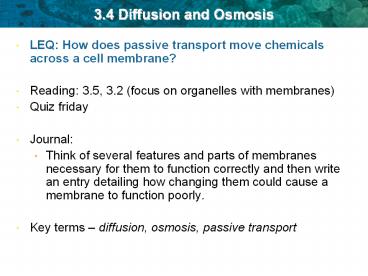3.4 Diffusion and Osmosis PowerPoint PPT Presentation
Title: 3.4 Diffusion and Osmosis
1
3.4 Diffusion and Osmosis
- LEQ How does passive transport move chemicals
across a cell membrane? - Reading 3.5, 3.2 (focus on organelles with
membranes) - Quiz friday
- Journal
- Think of several features and parts of membranes
necessary for them to function correctly and then
write an entry detailing how changing them could
cause a membrane to function poorly. - Key terms diffusion, osmosis, passive transport
2
3.4 Diffusion and Osmosis
Diffusion is the random movement of particles in
a solution.
- All molecules and atoms are in constant motion
- Energy
- Collision
- Heat (thermal energy)
- Diffusion applet (see screen)
- 3 general types of passive transport
3
- Journal prompt Have you ever been stuck in
crowd? A cramped elevator or a packed concert
can cause certain responses in people. Describe
how people might feel in a crowded space. - Construct an analogy to explain why molecules
diffuse from high to low concentrations using
crowds.
4
3.4 Diffusion and Osmosis
Materials move across membranes because of
concentration differences.
- Passive Transport
- Powered by random atomic molecular movement
- No energy requirements
5
3.4 Diffusion and Osmosis
1) Some chemicals can move across the cell
membrane by simple diffusion.
- Diffusion gradients
- Differences in concentration
- Net movement
- high ? low
- small, nonpolar solutes
- O2, CO2, steroids
6
3.4 Diffusion and Osmosis
2) Many solutes can only pass across a membrane
through facilitated diffusion.
- Facilitated diffusion moves chemicals through
specialized transport proteins - Small or large
- Polar, Ionic
- Regulation
- Size/shape restricted
- gates
7
3.4 Diffusion and Osmosis
- 3) Osmosis is the net movement of water in
response to solute concentrations and pressure
- Cells are sensitive to changes in solutions
- Water diffuses down concentration gradients
- Weakly via simple diffusion
- Facilitated
- aquaporins
8
3.4 Diffusion and Osmosis
- normalcy for animal cells
- equilibrium
- expansion
- cell death (lysis)
- Crenation (wrinkling)
- dysfunctional
9
Summary
- Explain what a concentration gradient is and what
it means for a molecule to diffuse down its
concentration gradient - Explain why facilitated diffusion does not
require energy from a cell - A cell is bathed in fluid. However, you notice
that water is flowing out of the cell. In what
kind of solution is this cell immersed isotonic,
hypotonic, or hypertonic? - How are receptors and transport proteins similar?
10
Answers
- A concentration gradient is the difference in
concentration of a substance from one location to
another. A molecule diffuses down its
concentration gradient by moving from one region
of higher concentration to a region of lower
concentration. - No energy is needed because the molecules move
down an concentration gradient - Hypertonic
- Both are proteins and may work with only specific
molecules. In addition, both may require a
change in shape to accomplish their function.

